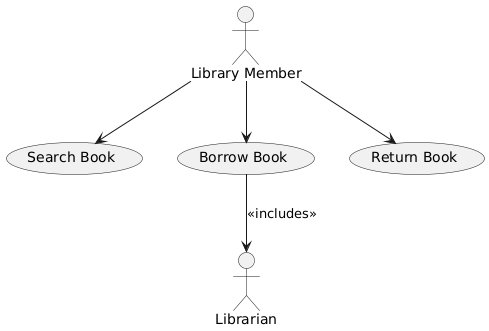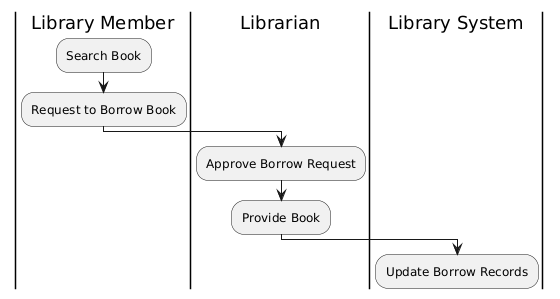Use Case Diagram Examples
Some examples of the requested Use Case Diagrams using PlantUML syntax:
1. Simple Use Case Diagram: Borrow Book
@startuml
actor "Library Member" as user
actor "Librarian"
usecase "Search Book" as UC1
usecase "Borrow Book" as UC2
usecase "Return Book" as UC3
user --> UC1
user --> UC2
user --> UC3
UC2 --> "Librarian" : <<includes>>
@endumlUsecase
Explanation:
- Actors:
- Library Member is the main actor who interacts with the system.
- Librarian is included in the “Borrow Book” process.
- Use Cases:
- The Library Member can Search Book, Borrow Book, and Return Book.
- The Borrow Book use case includes Librarian interaction.
2. Use Case with Subsystem: Library Management System
@startuml
package "Library Management" {
actor "Library Member" as user
actor "Librarian"
package "Book Management" {
usecase "Search Book" as UC1
usecase "Borrow Book" as UC2
usecase "Return Book" as UC3
}
package "User Management" {
usecase "Register User" as UC4
usecase "Login" as UC5
}
user --> UC1
user --> UC2
user --> UC3
user --> UC4
user --> UC5
Librarian --> UC2
}
@endumlUsecase
Explanation:
- Subsystems:
- The Library Management system is broken into two subsystems: Book Management and User Management.
- Actors:
- Library Member can interact with both subsystems.
- Librarian interacts with the Borrow Book use case in the Book Management subsystem.
- Use Cases:
- The Library Member can perform actions related to both books and user management.
3. Use Case with Swimlanes: Borrow Book Process
@startuml
|Library Member|
:Search Book;
:Request to Borrow Book;
|Librarian|
:Approve Borrow Request;
:Provide Book;
|Library System|
:Update Borrow Records;
@endumlUsecase
Explanation:
- Swimlanes:
- The diagram is divided into three swimlanes: Library Member, Librarian, and Library System.
- Flow:
- The Library Member searches for a book and requests to borrow it.
- The Librarian approves the request and provides the book.
- The Library System updates the borrow records after the transaction.
These diagrams illustrate key scenarios:
- Simple Use Case Diagram: Basic interaction between actors and use cases.
- Use Case with Subsystem: Use cases organized into logical subsystems.
- Use Case with Swimlanes: Clear distinction of responsibilities across different roles in a process.


